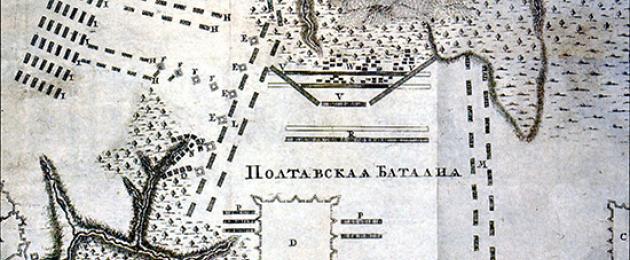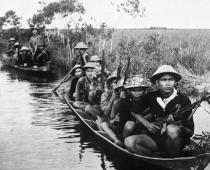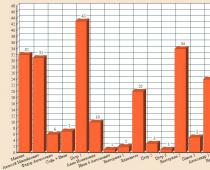Home Encyclopedia History of wars More
Poltava battle
P.D. Martin. Battle of Poltava. 1720
State Museum-Reserve "Tsarskoye Selo"
The historical attempt of the Russian state to regain the original Russian lands on the shores of the Gulf of Finland and at the mouth of the Neva (Novgorod Pyatina) and thereby gain access to the Baltic Sea resulted in a long Northern War of 1700-1721. The turning point of this war was the general battle between the Russian and Swedish armies on June 27 (July 8, new style) 1709 near Poltava.
In the summer of 1708, the Swedish army of King Charles XII set out on a campaign against Russia, moving in the direction of Moscow. When the Swedes approached the line of its state border, they saw that the pp. Whirlwinds and Gorodny is worth the Russian army. Charles XII abandoned the idea of giving her a general battle and turned south, to Ukraine, where he was invited by the traitor hetman Ivan Mazepa.
After the defeat of the Swedish corps of General Levengaupt near the village of Lesnaya (Peter I called this battle "the mother of the Poltava battle"), the king found himself in a difficult situation: the Russian army was pursuing the enemy, and Mazepa, who promised to bring all Ukrainian Cossacks to Charles XII, brought only about 2 thousand a man of the Cossack foreman and the personal regiment of "Serdyukov". Those at night fled from the hetman (about 700 people remained), to whom the king gave 20 Swedes for personal protection. In addition, General Alexander Menshikov, by royal decree, defeated the Mazepin headquarters of Baturin, in which significant supplies were collected for the Swedes, primarily food.
Charles XII brought the army of Sweden to Ukraine, which was distinguished by high professional training, discipline and won many convincing victories in the lands of Denmark, Saxony and Poland. On her account there was a victory over the young regular army of Peter the Great in 1700 near the fortress of Narva.
The Swedes had a hard time in Ukraine. The partisans met them back in Belarus. The "flying" detachments of the Russian dragoon cavalry and irregular cavalry, primarily the Cossack, haunted the royal army. The earth burned under the feet of the invaders. The attempt of the king and the hetman to use the separatist sentiments of a small part of the Zaporozhye Cossacks, led by ataman Gordiyenko, did not change the course of events. The Ukrainian Cossacks turned their backs on the hetman - "Polyakh", who was awarded in absentia by Tsar Peter I the cast-iron "Order of Judas". World history knows nothing of the kind.
During the winter of 1708 - 1709. Russian troops, avoiding a general battle, continued to wear down the forces of the Swedish army in local battles. In the spring of 1709, Charles XII decided to resume the attack on Moscow through Kharkov and Belgorod. To secure his rear, he decided to take the fortress city of Poltava. The Swedish army approached it with a force of 35 thousand people with 32 guns, not counting the Mazepins and Cossacks.
Poltava stood on the high bank of the Vorskli River. Its fortifications consisted of a shaft with a palisade on top with loopholes for firing guns. The garrison, commanded by Colonel Alexei Kelin, consisted of 4,187 soldiers, 2,500 Poltava Cossacks and armed townspeople, and 91 gunners. The fortress had 28 guns.
From the first days of the siege, the Swedes began to storm Poltava over and over again. Its defenders repelled 12 enemy attacks in the month of April alone, often making daring and successful sorties themselves. The siege work did not stop. On June 21 and 22, the most violent assaults were repulsed: the attackers, who even managed to hoist a banner on the ramparts, were thrown off it with a counterattack. For 2 days, the Poltava garrison lost 1,258 people killed and wounded, the Swedes - 2,300 people.
Tsar Peter I was able to help the besieged garrison with people and gunpowder, the stocks of which in Poltava were running out. Gunpowder was "sent" to the city in hollow bombs that did not explode when they hit the ground.
Meanwhile, the army of Peter I was drawn to Poltava. It numbered 42 thousand people with 72 guns. It consisted of 58 battalions of infantry (infantry) and 72 squadrons of cavalry (dragoons). The Ukrainian Cossack regiments were commanded by the new elected hetman Skoropadsky, who guarded the Poltava field from the side of Malye Budishchi, blocking the possible retreat route of the Swedes to Poland.
The heroic defense of Poltava gave the Russians a gain in time. On June 16, a military council, at which the tsar and his associates decided to give the enemy a general battle: "to cross the Vorskla near the village of Petrovka and, with the help of God, seek happiness over the enemy."

V. P. Psarev. Peter the Great and his Companions
The fact that the enemy was going to cross the Vorskla became known in the Swedish camp. Charles XII decided to conduct a reconnaissance, but near the river they were fired upon by Russian sentinel posts. Then the retinue of the monarch ran into a Cossack picket, and the king was wounded by a bullet in the leg. He had to watch the Battle of Poltava from a stretcher.
The battle of Poltava became a test of maturity for the young Russian regular army. And she passed this test with honor. Russian military art surpassed the Swedish, which was admired by all of Europe. The enemy army was completely defeated, ceasing to exist as such.
The Russian command prepared thoroughly for the battle. Peter I ordered to move the army camp closer to the fortress, about 5 km in a straight line from the Swedish camp. It was fortified with trenches (trenches) with bastions at the corners. A kilometer from the camp, on the battlefield, a system of field fortifications was created, which military practice did not yet know. The tsar ordered to build a line of 6 frontal redoubts in front of the camp, and 4 more (the two front ones did not have time to complete) - perpendicular to them.

Plan of Poltava Victoria from the book "The Life and Glorious Deeds of Peter the Great ..." St. Petersburg. 1774 RGADA
Earthen redoubts had a quadrangular shape and were located at a distance of a direct gun shot from each other. This ensured tactical interaction between the redoubt garrisons. They housed two battalions of infantry and grenadiers, regimental guns (1 - 2 per redoubt). The system of redoubts became the advanced position of the Russian army, against which the first enemy attack was to be broken. This was a new word in the military art of European armies at the beginning of the 18th century.
Another tactical innovation was the deployment of 17 dragoon regiments just behind the redoubts. The regiments were commanded by the famous cavalry commander of the Northern War, the future Generalissimo A.D. Menshikov. The dragoon cavalry was to attack the Swedes on the line of redoubts and between them in the initial phase of the general battle.
Peter I planned to wear down the enemy at the forefront (line of redoubts) and then defeat him in an open field battle. He perfectly understood the strength and weakness of the linear battle formation. The redoubts were intended to break the linear battle order of the Swedish army, disrupt its adhesion and bring the troops of Charles XII under flank fire from a fortified camp. After that, it was necessary to break the scattered royal army in parts.
At the military council on June 25, the Swedes decided to be the first to attack the enemy. Charles XII did not wait for help from Poland and from the Crimean Khan. He decided at night to suddenly attack the camp of the tsar's army from all sides before the Russians left it and lined up for battle. It was planned to throw them off a cliff into the river. For the speed of movement, it was decided not to take artillery, but to take only 4 guns with them. For the blockade of the Poltava fortress, 2 infantry battalions (1,300 soldiers) and about 8,000 Cossacks and Mazepins were left. The king did not trust the allies. In total, about 22 thousand people were allocated for the night attack: 24 infantry battalions and 22 cavalry regiments.
June 27 at two o'clock in the morning the Swedish army under the command of Field Marshal K.G. Renshild (the king with a drawn sword, his bodyguards - drabans carried on a stretcher) with four columns of infantry and six columns of cavalry secretly moved towards the position of the enemy. Charles XII urged the soldiers to bravely fight the Russians and invited them after the victory to a feast in the tents of the Moscow Tsar.
The Swedish army moved towards the redoubts and stopped at night 600 meters from the front fortifications. From there, the sound of axes was heard: it was 2 advanced redoubts being hastily completed. The Swedes deployed in advance in 2 battle lines: the 1st consisted of infantry, the 2nd - of cavalry. Suddenly, a pistol shot rang out - a Russian horse patrol detected the approach of the enemy. Warning fire was fired from the redoubts.
Field Marshal Rehnschild at five o'clock in the morning ordered an attack on the redoubts. But the Swedes were able to take two of them, which they did not have time to complete. The garrisons of the other two - perpendicular ones fought off with the help of soldiers who had left the fortifications captured by the Swedes. Those received an unpleasant surprise: they only knew about a line of six transverse redoubts. They did not have to be stormed: the Russian dragoon regiments of Generals Menshikov and K.-E. Renne. The Swedish cavalry went ahead of the infantry, a battle ensued.
The dragoons pushed back the royal squadrons and, on the orders of Peter I, retreated behind the line of longitudinal redoubts. When the Swedes resumed their attack, they were met with heavy rifle and cannon fire from the field fortifications. The right flank of the royal army, caught in the crossfire and having suffered heavy losses, retreated in disarray to the forest near the village of Malye Budishchi.
The calculation of Peter I on the dismemberment of the enemy army at the beginning of the battle fully justified itself. The right-flank columns of Generals K.G. Ross and V.A. Schlippenbach was destroyed by the dragoons of General Menshikov.
The main forces of the parties clashed at dawn. At about 6 o'clock, Peter I built the Russian army in front of the camp in 2 battle lines. The peculiarity of the construction was that each regiment had its own, and not someone else's, battalion in the second line. This created the depth of the battle formation and reliably provided support for the first battle line. The second line of infantry received a tactical assignment, which was a major step forward in the development of linear tactics. The center was commanded by the general prince. The tsar assigned the general command of the troops to Field Marshal B.P., experienced in the war. Sheremetev.
The Swedish army, which had broken through the line of redoubts to lengthen its line of battle, formed up in one line of battle with a weak reserve behind. The cavalry stood on the flanks in two lines. The Swedes were very determined.
At 9 o'clock in the morning the first line of Russians moved forward. The Swedish army also moved closer. After a short mutual salvo rifle fire (from a distance of a little more than 50 meters), the Swedes, ignoring the cannon fire, rushed into a bayonet attack. They sought to get close to the enemy as soon as possible and avoid destructive artillery fire.
The right wing of the royal troops, under which Charles XII was, pressed the battalion of the Novgorod infantry regiment, which was attacked by 2 Swedish. There was a threat of a breakthrough of the Russian position almost at its very center. Peter I, who galloped here, personally led the second battalion of Novgorodians, who was standing in the second line, in a counterattack, which overturned the Swedes who had broken through with a swift blow, and closed the gap formed in the first line.
The Swedish frontal attack bogged down, and the Russians began to push the enemy. A fierce battle was going on along the entire line of contact between the parties. The line of Russian infantry began to cover the flanks of the royal infantry battalions. The Swedes panicked, many soldiers began to hastily leave the battlefield, fearing the environment. The Swedish cavalry sped off without resistance into the Budishchi forest; the foot soldiers followed her there. And only in the center, General Lewenhaupt, next to whom was the king (his stretcher was broken by a cannonball), tried to cover the retreat to the carts.
The Russian infantry pursued the retreating Swedes to the Budishchensky forest and at 11 o'clock lined up in front of the last forest that hid the fleeing enemy. The royal army was defeated and fled in disorder, led by the king and hetman Mazepa, from Poltava to the crossings across the Dnieper.
In the battle near Poltava, the winners lost 1,345 people killed and 3,290 wounded. The losses of the Swedes on the battlefield were estimated at 9 thousand 333 killed and 2 thousand 874 prisoners. Among the prisoners were Field Marshal Rehnschild, Chancellor K. Pieper and part of the generals. Russian trophies were 4 cannons and 137 banners, the enemy's convoy and his siege camp.
The remnants of the fleeing Swedish army covered about 100 km in two days and reached Perevolochna on June 29. At 8 o'clock in the morning, the exhausted Swedes began to search in vain for funds to cross the full-flowing river. Then they dismantled the wooden church and built a raft, but it was carried away by the river current. Closer to the night, several ferry boats were found, to which wheels from carriages and wagons were added: improvised rafts were obtained.
But only King Charles XII and the deposed Hetman Mazepa with about a thousand close associates and bodyguards managed to cross to the western bank of the Dnieper. Pursuers approached Perevolochna: a guards brigade led by General Prince Mikhail Golitsyn, 6 dragoon regiments of General R.Kh. Bour and, finally, 3 cavalry and 3 foot regiments led by Menshikov. He accepted at 2 pm on June 30 the surrender of the Swedish army abandoned by the king, who did not think about resistance. 142 banners and standards lay at the feet of the winners. In total, 18,746 Swedes were taken prisoner, almost the entire generals, all their artillery, the entire army convoy. King Charles XII and the hetman-traitor Ivan Mazepa fled to the Turkish borders, having managed to deceive the chase sent after them in the steppe.

Kivshenko A.D. Poltava battle
The Swedes bow their banners before Peter I. 1709

Triumphant entry of Russian troops into Moscow
December 21, 1709 after the victories at Lesnaya and near Poltava.
Engraving by etching and cutter by A. Zubov. 1711
Prominent generals of Europe highly appreciated the art of the Russian army in the battle of Poltava. The largest Austrian commander Moritz of Saxony wrote: “This is how, thanks to skillful measures, you can make happiness bend in your direction.” The French military theorist of the first half of the 18th century, Rokoncourt, advised learning from the military art of Peter I. About the Battle of Poltava, he wrote the following: “Such a decisive victory over the best disciplined European troops was not a well-known omen of what the Russians would do over time ... Indeed, this battle should be noted a new tactical and fortification combination that would be real progress for both. By this very method, until then not used, although equally convenient for attack and defense, the entire army of the adventurer Charles XII was to be destroyed.
High marks for the actions of the Russian army in the general battle of the Northern War were also given by domestic researchers. So, A. Puzyrevsky noted: "Poltava is the only example in the military history of an offensive fortified position."

Monument of Glory in Poltava. 1805-1811 Installed in honor of the victory of the Russian army over the Swedish troops in the Battle of Poltava.
Architect J. Thomas de Thomon, sculptor F.F. Shchedrin
The Poltava victory meant a radical turning point in the ongoing war. Now the strategic initiative is completely in the hands of Russia. Victoria near Poltava significantly raised the authority of the Russian state, put Tsar Peter I in the ranks of the most skillful commanders not only of his era. Russian military art was recognized as advanced, innovative.
Alexey Shishov,
Candidate of Historical Sciences, Senior Researcher
Research Institute of Military History
Military Academy of the General Staff
Armed Forces of the Russian Federation
- In contact with 0
- Google Plus 0
- OK 0
- Facebook 0








